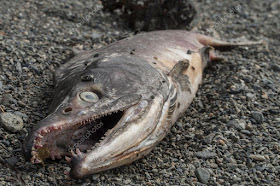The Height Of A Dead Salmon
The methodology is straightforward. You take your subject and slide them into an fMRI machine, a humongous sleek, white ring, like a donut designed by Apple. Then you show the subject images of people engaging in social activities — shopping, talking, eating dinner. You flash 48 different photos in front of your subject's eyes, and ask them to figure out what emotions the people in the photos were probably feeling. All in all, it's a pretty basic neuroscience/psychology experiment. With one catch. The "subject" is a mature Atlantic salmon.
And it is dead.
The experiment was run in 2009 and drew a fair amount of attention at the time, perhaps because it allowed editors to write headlines like "fMRI Gets Slap In The Face With A Dead Fish" and "Scanning Dead Salmon in fMRI Machine Highlights Risk Of Red Herrings." The paper, which carried the droll title "Neural correlates of interspecies perspective taking in the post-mortem Atlantic Salmon: An argument for multiple comparisons correction" didn't show that dead salmon have thoughts about human social interactions, and it didn't show that fMRI is junk. It showed, as one writer put it, that "bad statistics lead to bad science."
 |
| "Guess what I'm thinking right now!" |

